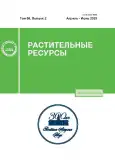Effect of Dry Storage on Seed Germination of Ephedra monosperma (Ephedraceae)
- Autores: Borisova S.Z.1
-
Afiliações:
- Ammosov North-Eastern Federal University
- Edição: Volume 59, Nº 2 (2023)
- Páginas: 145-151
- Seção: Biology of Resource Species
- URL: https://journals.rcsi.science/0033-9946/article/view/138783
- DOI: https://doi.org/10.31857/S0033994623020036
- EDN: https://elibrary.ru/ZMPIPR
- ID: 138783
Citar
Texto integral
Resumo
Abstract
—Effects of dry storage under ambient laboratory conditions on germination and survival was tested for seeds of rare species Ephedra monosperma. The seeds without pregermination treatment were placed in Petri dishes with a moistened filter paper at room temperature 20 ± 3 °C. Seeds maintain high germination when dry stored for 5 years (mesobiotic), further storage leads to a sharp decrease in germination. At the same time, dry storage of seeds does not change the time of the beginning of germination, the duration of germination and the curve of seed germination. Freshly harvested seeds and seeds stored at room temperature germinate 2–4 days after seeding, 50% of seeds – in 7 days, and 98–100% – within 2 weeks. The seed germination curve has two peaks; the highest one is the first, which is observed on the 3rd day from the start of germination.
Palavras-chave
Sobre autores
S. Borisova
Ammosov North-Eastern Federal University
Autor responsável pela correspondência
Email: borisova_sz@mail.ru
Russia, Yakutsk
Bibliografia
- [Plant Resources of Russia: The component composition and biological activity of plants. Divisions Lycopodiophyta – Gnetophyta]. 2016. V. 7. St. Petersburg; Moscow. (In Russian)
- Ibragic S., Sofic Е. 2015. Chemical composition of various Ephedra species. – Bosn. J. Basic Med. Sci. 15(3): 21–27. https://doi.org/10.17305/bjbms.2015.539
- Koropachinsky I.Yu., Vstovskaija T.N. 2002. [Woody plants of the Asian part of Russia] Novosibirsk. 707 p. (In Russian)
- Peshkova G. 2005. On the origin of the genus Ephedra L. (Ephedraceae). – Turczaninowia. 8(2): 54–68. https://www.elibrary.ru/item.asp?id=11158208 (In Russian)
- Ivanova V.P. 1967. [On the steppe vegetation in the middle Lena river valley]. – Uchenye zapiski YaGU. 17: 11–19. (In Russian)
- Danilova N.S., Borisova S.Z. 2010. Populations of Krascheninnikovia lenensis (Kumin.) Tzvel. in the territory of Yakutia. – Vestnik YaGU. 7(2): 19–22. https://www.s-vfu.ru/universitet/rukovodstvo-i-struktura/strukturnye-podrazdeleniya/dnii/vestnik-svfu/arkhiv/arkhiv-2010/2-2010.pdf (In Russian)
- Egorova А.А. 2013. [Vascular plants of the South-Western Yakutia]. Novosibirsk. 203 p. (In Russian)
- Nikolin E.G. 2013. [The abstract of flora of the Verkhoyansk Ridge]. Novosibirsk. 248 p. (In Russian)
- Danilova N.S., Semenova V.V. 2015. Phytocenotic charateristic of communities with participation of Astragalus angarensis (Fabaceae) in Central Yakutia. – Scientific J. KubSAU. 113(09): 174–183. http://sj.kubsau.ru/2015/09/14.pdf (In Russian)
- Borisova S.Z., Danilova N.S., Ivanova N.S. 2016. Characteristics of Population of Artemisia obtusiloba subsp. martjanovii Krasch. ex Poljak. in Central Yakutia. – Herald of the NEFU. 5(55): 5–17. https://www.s-vfu.ru/universitet/rukovodstvo-i-struktura/strukturnye-podrazdeleniya/dnii/vestnik-svfu/arkhiv/arkhiv-2016/Вестник%205%20(55)%202016.pdf (In Russian)
- [The Red Book of the Republic of Sakha (Yakutia). V. 1: Rare and endangered species of plants and fungi]. 2017. Moscow. 412 p. https://minpriroda.sakha.gov.ru/uploads/ckfinder/userfiles/2023/02/20/files/Красная%20книга%20растений%20Якутии%202017_compressed%20(1).pdf (In Russian)
- Nikolaeva M.G., Lyanguzova I.V., Pozdova L.M. [Seed Biology]. 1999. St. Petersburg. 232 p. (In Russian)
- Kinzel W. 1915. Frost und Licht als beeinflussende Krӓfte bei der Samenkeimung. Erläuterungen und Ergänzungen zum ersten Buche. Stuttgart. 187 p.
- Nikolaeva M.G., Razumova M.V., Gladkova V.N. [Handbook of germinating dormant seeds]. 1985. Leningrad. 348 p. (In Russian)
- Borisova I.V. 1996. Seed germination types in steppe and desert plants. – Bot. Zhurn. 81(12): 9–22. http://arch.botjournal.ru/?t=issues&id=19961212&rid=pdf_0005070 (In Russian)
- Rodríguez-Araujo M.E., Milano C., Pérez D.R. 2019. Germination of Ephedra ochreata Miers: Contribution for productive restoration of arid environments in Argentina. – Agrociencia. 53(4): 617–629. https://agrociencia-colpos.org/index.php/agrociencia/article/view/1832
- Baskin C.C., Baskin J.M. 2014. Seeds: Ecology, Biogeography and Evolution of Dormancy and Germination. San Diego. 586 p. https://doi.org/10.1016/B978-0-12-080260-9.X5000-3
- Meyer S.E. 2008. Ephedra L. – In: The Woody Plants Seed Manual. Washington. P. 492–494. https://www.fs.usda.gov/rm/pubs_series/wo/wo_ah727.pdf
- Young J.A., Evans R.A., Kay B.L. 1977. Ephedra seed germination. – Agron. J. 69(2): 209–211. https://doi.org/10.2134/agronj1977.00021962006900020004x
- Derbel S., Touzard B., Triki M.A., Chaieb M. 2010. Seed germination responses of the Saharan plant species Ephedra alata ssp. alenda to fungicide seed treatments in the laboratory and the field. – Flora. 205(7): 471–474. https://doi.org/10.1016/j.flora.2009.12.025
- Wang J.-H., Cui X.-L., Chen X.-L., Du G.-Z. 2007. Comparative study of seed germination, seed size and their relationships in mesad and siccocolous. – Chin. J. Plant Ecol. 31(6): 1037–1045. https://doi.org/10.17521/cjpe.2007.0131 (In Chinese)
- Wang J.-H., Baskin C.C., Cui X.-L., Du G.-Z. 2009. Effect of phylogeny, life history and habitat correlates on seed germination of 69 arid and semi-arid zone species from northwest China. – Evol. Ecol. 23(6): 827–846. https://doi.org/10.1007/s10682-008-9273-1
- Androsova D.N., Danilova N.S. 2018. Germination and seed sprouting pattern of rare plants of Yakutia. – Arctic and Subarctic Natural Resources. 26(4): 80–88. https://doi.org/10.31242/2618-9712-2018-26-4-80-88 (In Russian)
- Gavrilova M.K. 1973. [The Climate of Central Yakutia]. Yakutsk. 120 p. (In Russian)
Arquivos suplementares











